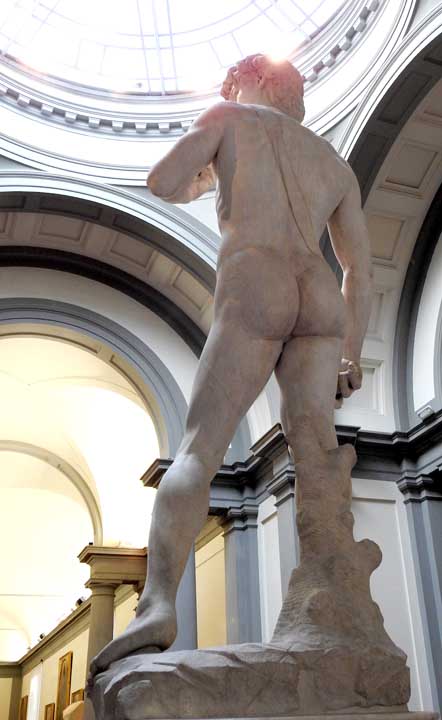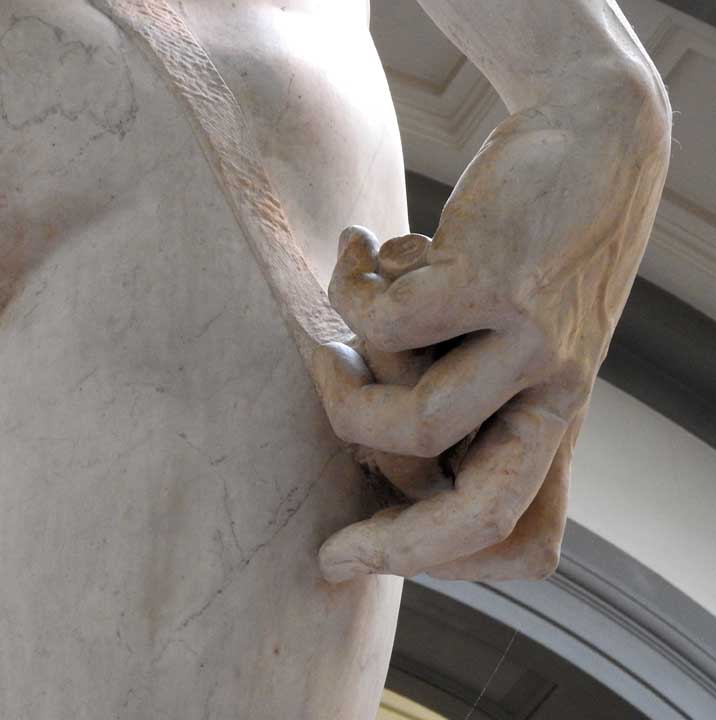Galleria dell'Accademia - Table of Contents ...................Michelangelo on European Architects and Artistsart.................. Architecture Around the World
Galleria
dell'Accademia di Firenze / Gallery of the Academy of
Florence
"Accademia" pronounced: ock a DEEM ee a
Florence,
Italy
February 2020 PhotosOn this page below:
History of the Accademia Gallery
| See other
works by
Michelangelo on Buffalo Architecture and History |
|
The Accademia Gallery was established in the eighteenth century as a teaching facility for students of the adjacent Academy of Fine Arts and was founded in 1784 by Grand Duke Peter Leopold of Lorraine. It is located in the ancient buildings of the Hospital of Saint Matthew and the Convent of Saint Niccoḷ of Cafaggio, the halls of which were used to display ancient artworks as didactic models for students of the Academy of Fine Arts. The Accademia Gallery was progressively enriched by paintings gathered from convents/monasteries that were suppressed by Grand Duke Peter Leopold of Lorraine at the end of the eighteenth century and by Napoleon in 1810. The statue of Michelangelo’s David, located in Piazza della Signoria, was transferred to the Accademia Gallery in 1873 for reasons of conservation, although the original intention was to create a museum dedicated to Michelangelo, with original sculptures and drawings, to celebrate the fourth centenary of the artist’s birth. For this occasion, the architect Emilio de Fabris paid Michelangelo a special tribune with a large, projecting skylight to shelter David, eventually completed in 1882. Between the end of the nineteenth century and the early years of the twentieth century, the Gallery, which was by this time administratively separate from the Accademia di Belle Arti, was reorganised, with some of the ancient paintings having been transferred to other city museums. At the same time, the Accademia Gallery was enhanced by the addition of other masterpieces by Michelangelo, such as the statue of St. Matthew, purchased in 1906, and in 1909 by the four large statues of the Slaves/Prisoners, originating from Grotta del Buontalenti in the Boboli Gardens. |
Four
unfinished Prisoners Background: David ... Foreground Hall of the Prisoners: Four unfinished Prisoners and a statue of Saint Matthew ... "Hall of the Prisoners, which takes its name from the four large sculptures depicting the male nudes known as the Slaves/Prisoners/Captives. "They were begun by Michelangelo as part of a grandiose project for the tomb of Pope Julius II della Rovere in 1505; however, due to a mounting shortage of funds, the pope ordered him in 1506 to put the project aside. "After the artist’s death, four of the Prisoners were found in his studio, and his nephew Leonardo Buonarroti donated them to Duke Cosimo I de Medici. In 1586, Bernardo Buontalenti placed the Slaves at the corners of the large grotto in the Boboli Gardens of Palazzo Pitti, where they remained until 1908 before being transferred to the Accademia Gallery in 1909." - Florence Inferno (online June 2020) |
|
Michelangelo’s
Prisoners
or Slaves
They are some of the finest examples of Michelangelo’s habitual working practice, referred to as “non-finito” (or incomplete), magnificent illustrations of the difficulty of the artist in carving out the figure from the block of marble and emblematic of the struggle of man to free the spirit from matter. These sculptures have been interpreted in many ways. As we see them, in various stages of completion, they evoke the enormous strength of the creative concept as they try to free themselves from the bonds and physical weight of the marble. It is now claimed that the artist deliberately left them incomplete to represent this eternal struggle of human beings to free themselves from their material trappings. "The Prisoners’ heads and faces are the least-developed parts, but they are to communicate with their poses, known as the classic “contrapposto” (counter pose). The Slaves are standing with most of their weight on one foot so that their shoulders and arms twist off-axis from the hips and legs. This precise pose gives the Prisoners a more dynamic and powerful appearance, transmitting motion and emotion. "All the unfinished statues at the Accademia reveal Michelangelo’s approach and concept of carving. Michelangelo believed the sculptor was a tool of God, not creating but simply revealing the powerful figures already contained in the marble. Michelangelo’s task was only to chip away the excess, to reveal. He worked often for days on end without sleep, keeping for days his boots and clothes, as reported in Vasari’s chronicles about Michelangelo’s passion and talent. One can clearly recognize the grooves from mallet and pointed chisel on the marble surface used in this initial stage. Unlike most sculptors, who prepared a plaster cast model and then marked up their block of marble to know where to chip, Michelangelo mostly worked free hand, starting from the front and working back. - Florence Inferno (online June 2020) |
Prisoner
- The
Awakening Slave Prisoner - The Awakening Slave ... Circa 1520-23 "...the
least outlined of the four
Prisoners. The figure feels like it is
writhing and straining, trying
to imminently explode out of the marble
block that holds it. The latent
power one feels is extraordinary.
Michelangelo is famous for saying
that he worked to liberate the forms
imprisoned in the marble. He saw
his job as simply removing what was
extraneous. This endless struggle
of man to free himself from his physical
constraints is a metaphor of
the flesh burdening the soul."
- Florence
Inferno (online June 2020)
 Prisoner - The Awakening Slave  Prisoner - The Awakening Slave |
Prisoner
- The Young
Slave Prisoner - The Young Slave "... seems almost
bound within himself, burying his
face in his left arm and hiding the right one
around the hips. The
contrapposto pose is quite exaggerated by the
narrowness of the block
of stone and by the slightly bent knees. The
profound study of human
anatomy is highlighted in the left elbow and the
careful lines of the
bent biceps and triceps. His face, which is just
beginning to emerge,
seems so youthful by comparison with his
musculature. Michelangelo
always chiseled out the image front to back: it
clearly shows within
the Young Slave, which appears to be emerging from
the rock that shows
the rough tracks of the large tooth chisels." - Florence
Inferno (online June 2020)
 Prisoner - The Young Slave  Prisoner - The Young Slave |
Prisoner - The Atlas  Prisoner - The Atlas "The male nude seems
to be carrying a huge weight on his head. Hence he
is named after
Atlas, the primordial Titan who held up the entire
world on his
shoulders. His head has not emerged from the
stone, leading the slave
to support and push such a heavy weight, which
threatens to compress
him. The force of weight pushing down, and that
pushing back up, create
a vigorous tension. There is no feeling of
equilibrium here, only an
eternal battle of forces threatening to explode in
both directions.
This pressure generates a power which perhaps more
than the other
Slaves, expresses the energy of the figure
struggling to emerge from
marble." - Accademia.org
(online June 2020)
 Prisoner - The Atlas  Prisoner - The Atlas |
Prisoner
- The
Bearded Slave Prisoner - The Bearded Slave "The most finished of
the four Slaves. The
figure is almost
free, only his hands and part of his arm, probably
planned to hold a
cloth, are unfinished. The face is covered by a
thick, curly beard and
the thighs are bound by straps of cloth. The torso
is finely modeled,
revealing Michelangelo’s deep knowledge of
anatomy." - Accademia.org
(online June 2020)
 Prisoner - The Bearded Slave  Prisoner - The Bearded Slave |
Saint
Matthew Saint Matthew ... 1503 "Michelangelo arrived
to Florence right after
Florence was declared a Republic in 1501 and he
spent four years there
being busy with commissions (starting with the
commission for creating
the David). The last commission which he
received was a
collection of twelve Apostles for the niches of
the Choir of the
Cathedral. Although we have the drawing for
another statue, St Matthew
was the only one he managed to complete before the
contract was annuled
when he moved to Rome in 1505.
"The figure of St Matthew is torqued around its central axis, a spasm of movement far different from the quite traditional pose of Michelangelo's David. Even in its unfinished state, Matthew's massive musculature suggests a deep reservoir of pent-up energy and divine inspiration." - Web Gallery of Art (online June 2020)  Saint Matthew  Saint Matthew  Saint Matthew |
|
This astonishing Renaissance sculpture was created between 1501 and 1504. It is a 14.0 ft marble statue depicting the Biblical hero David, represented as a standing male nude. Originally commissioned by the Opera del Duomo for the Cathedral of Florence, it was meant to be one of a series of large statues to be positioned in the niches of the cathedral’s tribunes, way up at about 80mt from the ground. Michelangelo was asked by the consuls of the Board to complete an unfinished project begun in 1464 by Agostino di Duccio and later carried on by Antonio Rossellino in 1475. Both sculptors had in the end rejected an enormous block of marble due to the presence of too many “taroli”, or imperfections, which may have threatened the stability of such a huge statue. This block of marble of exceptional dimensions remained therefore neglected for 25 years, lying within the courtyard of the Opera del Duomo (Vestry Board) Michelangelo was only 26 years old in 1501, but he was already the most famous and best paid artist in his days. Traditionally, David had been portrayed after his victory, triumphant over the slain Goliath. Michelangelo instead, for the first time ever, chooses to depict David before the battle. Contrapposto: The figure stands with one leg holding its full weight and the other leg forward, causing the figure’s hips and shoulders to rest at opposing angles, giving a slight s-curve to the entire torso. After more than two years of tough work, Michelangelo decided to present his “Giant” to the members of the Vestry Board and to Pier Soderini, the then gonfaloniere of the Republic. In January 1504, his 14 foot tall David was unveiled only to them: they all agreed that it was far too perfect to be placed up high in the Cathedral, thus it was decided to discuss another location in town. The city council convened a committee of about thirty members, including artists like Leonardo da Vinci, Sandro Botticelli and Giuliano da Sangallo, to decide on an appropriate site for David. During the long debate, nine different locations for the statue were discussed, and eventually the statue was placed in the political heart of Florence, in Piazza della Signoria. It took four days and forty men to move the statue the half mile from Michelangelo’s workshop behind Santa Maria del Fiore Cathedral to the Piazza della Signoria. Michelangelo then kept on working on the finer finishing. That summer, the sling and tree-stump support were gilded, and the figure was given a gilded victory-garland. Unfortunately, all gilded surfaces have been lost due to the long period of exposure to weathering agents. - Accademia.org (online June 2020)
|
Michelangelo's David Renaissance ... marble ... 1501 and 1504        |
|
Volterra's Bust
of Michelangelo   The sculpture was made following Michelangelo’s death in 1564, when the Renaissance master’s nephew Leonardo Buonarroti commissioned Daniele da Volterra with the task.  See another bust of Michelangelo by Volterra in the Capitoline Museum in Rome |
